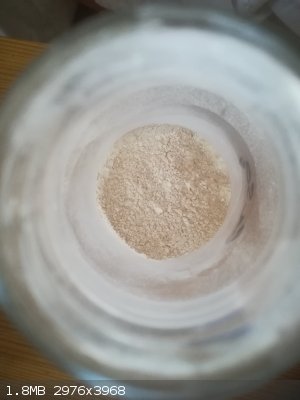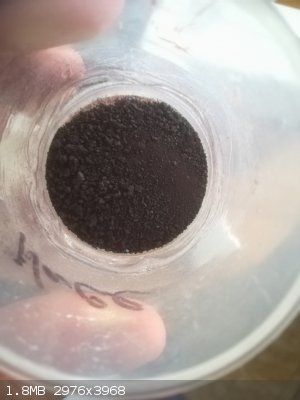Bedlasky
International Hazard
    
Posts: 1219
Registered: 15-4-2019
Location: Period 5, group 6
Member Is Offline
Mood: Volatile
|
|
Dehydratation of FeO(OH) and CaSO4
Hello.
I had some hydrated ferric oxide and calcium sulphate dihydrate from experiments I've made long ago. So I decided to dehydrated them in oven at
275°C. But I am little confused from result of this dehydration.
CaSO4 isn't white but beige. Is this normal or is it contaminated by some organic impurities?
Ferric oxide isn't red but black. Why?
 
|
|
|
fusso
International Hazard
    
Posts: 1922
Registered: 23-6-2017
Location: 4 ∥ universes ahead of you
Member Is Offline
|
|
Try magnet test. If it's attracted to magnet it's Fe3O4.
|
|
|
Ubya
International Hazard
    
Posts: 1232
Registered: 23-11-2017
Location: Rome-Italy
Member Is Offline
Mood: I'm a maddo scientisto!!!
|
|
most ferric oxide produced with wet chemistry is black. look at nurdrage's video on the preparation of ferric oxide for thermite, he uses 3 methods,
and only the electrolytic one gives red iron oxide
---------------------------------------------------------------------
feel free to correct my grammar, or any mistakes i make
---------------------------------------------------------------------
|
|
|
Bedlasky
International Hazard
    
Posts: 1219
Registered: 15-4-2019
Location: Period 5, group 6
Member Is Offline
Mood: Volatile
|
|
I tried this and it had not attracted to magnet.
Quote: Originally posted by Ubya  | | most ferric oxide produced with wet chemistry is black. look at nurdrage's video on the preparation of ferric oxide for thermite, he uses 3 methods,
and only the electrolytic one gives red iron oxide |
Thanks!
|
|
|
CharlieA
National Hazard
   
Posts: 645
Registered: 11-8-2015
Location: Missouri, USA
Member Is Offline
Mood: No Mood
|
|
Am I correct in assuming that Fe3O4 is a typo? Or is this FeO(dot)Fe2O3. I am not familiar with this substance.
|
|
|
oberkarteufel
Harmless

Posts: 47
Registered: 11-12-2018
Member Is Offline
Mood: Mayonesium sulfate
|
|
No, it's not a typo. This compound contains iron on both +III and +II oxidation states. There's also an oxide Pb3O4 with +II and +IV lead atoms.
Edit: Naturally occuring Fe3O4 is known as magnetite.
[Edited on 2-5-2019 by oberkarteufel]
|
|
|
CharlieA
National Hazard
   
Posts: 645
Registered: 11-8-2015
Location: Missouri, USA
Member Is Offline
Mood: No Mood
|
|
Quote: Originally posted by oberkarteufel  | No, it's not a typo. This compound contains iron on both +III and +II oxidation states. There's also an oxide Pb3O4 with +II and +IV lead atoms.
Edit: Naturally occuring Fe3O4 is known as magnetite.
Thank you. I have learned something and that is a good think
Charlie A |
|
|
|